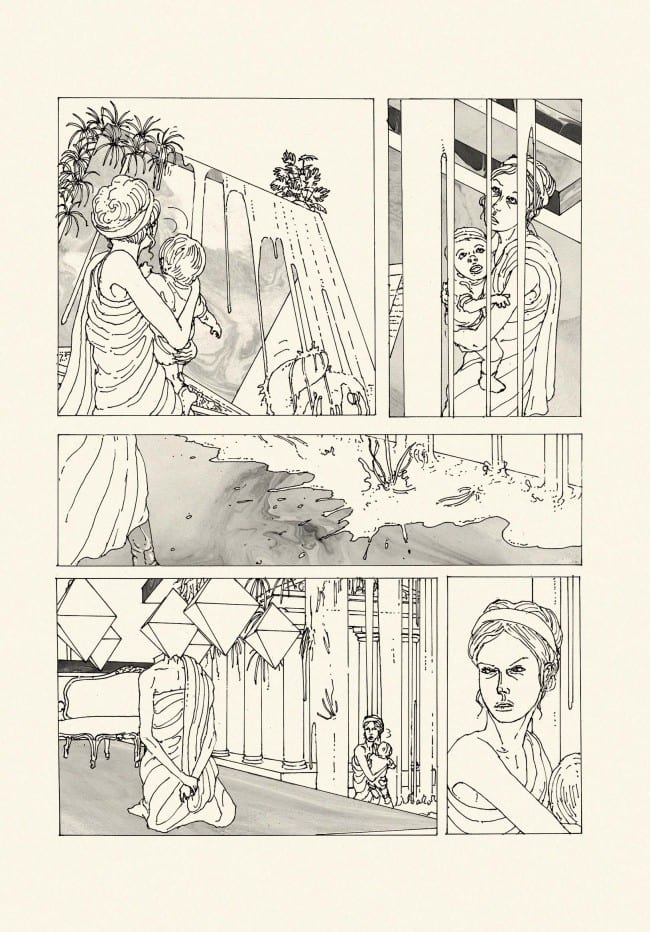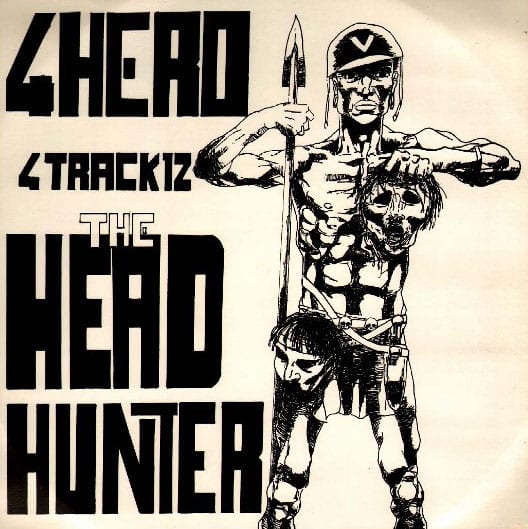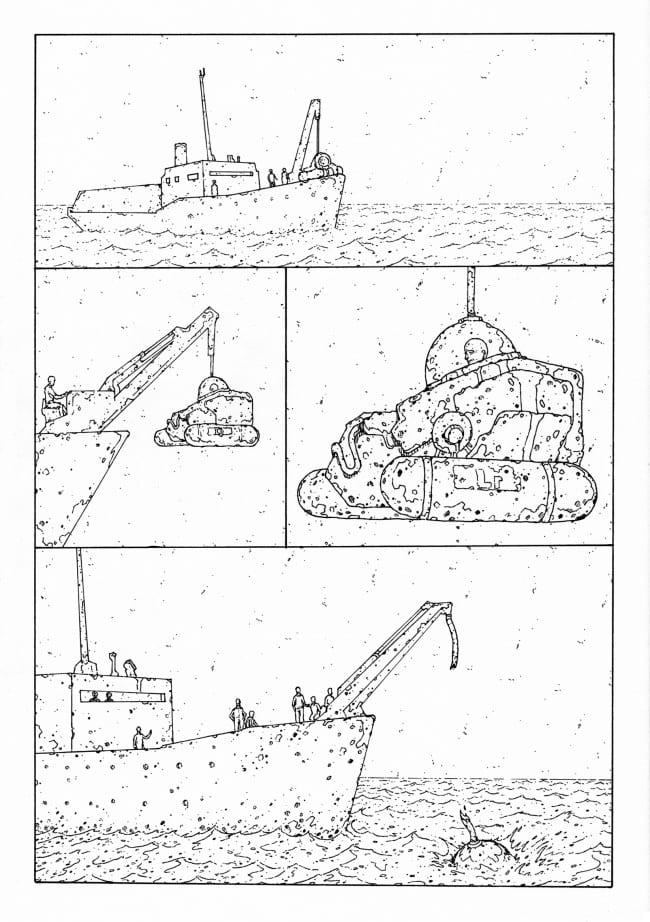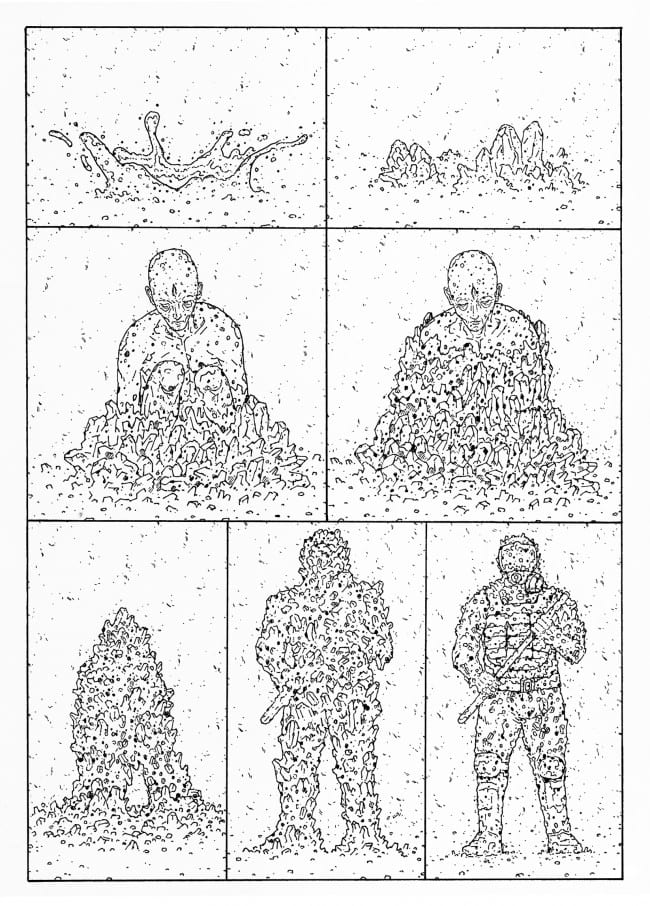 Although their self-published anthologies have spotlit a variety of work from different practitioners, to all intents and purposes the comics collective that goes under the name Decadence consists of two artists and two intersecting visions. Stathis Tsemberlidis and Lando have been self-publishing books under the Decadence label since the early 2000s, following their first meeting while studying animation in London. Since graduating from university in 2003 they've been slowly picking up followers and admirers with each new release – so far totalling ten mini-comics each, ten anthologies and two ultra-rare "specials", alongside contributions to the Famicon and Landfill's Mould Map and an organisational hand in Bristol's Bear Pit Zine Fair - and putting together a body of work that, though upfront and honest in its amalgamation of influences, nonetheless has a kick that is all it's own. A combination of brain warping psychedelia, far-flung sci-fi, radical politics and evolutionary theory that side-steps the stuffiness of a lot of high-concept science fiction and comes across as its hip, wise-cracking younger brother. Headphones on, hood up, speaking a language that consists of nothing but indecipherable squiggles and capable of seeing far into the dark, dry future.
Although their self-published anthologies have spotlit a variety of work from different practitioners, to all intents and purposes the comics collective that goes under the name Decadence consists of two artists and two intersecting visions. Stathis Tsemberlidis and Lando have been self-publishing books under the Decadence label since the early 2000s, following their first meeting while studying animation in London. Since graduating from university in 2003 they've been slowly picking up followers and admirers with each new release – so far totalling ten mini-comics each, ten anthologies and two ultra-rare "specials", alongside contributions to the Famicon and Landfill's Mould Map and an organisational hand in Bristol's Bear Pit Zine Fair - and putting together a body of work that, though upfront and honest in its amalgamation of influences, nonetheless has a kick that is all it's own. A combination of brain warping psychedelia, far-flung sci-fi, radical politics and evolutionary theory that side-steps the stuffiness of a lot of high-concept science fiction and comes across as its hip, wise-cracking younger brother. Headphones on, hood up, speaking a language that consists of nothing but indecipherable squiggles and capable of seeing far into the dark, dry future.
Reading through their releases you get the feeling that both artists are asking the same questions of the same situations but that they are speaking in different languages. Their work reads beautifully together, one almost completing the other. Both are pure sci-fi artists - if by sci-fi you hold to that old chestnut about it being set in the future but dealing with the now – but their approaches differ. Crudely, where Lando is the apocalyptic futurist, dealing with the nuts and bolts of worlds in strife and the realities of survival in far off lands, Tsemberlidis is the mystic – concerned with humanity's evolution and possible escape routes from a destructive manichean present in which it is imprisoned within false divisions. If this sounds like some hippy throwback, well, perhaps it is, but the execution is sharp and unsentimental. There is no easy-way-out spirituality being offered here. Both artists are aware that hard choices need to be made if we are to escape the mess we have made for ourselves and that large parts of our way of living will have to be jettisoned. In the words of mathematician and philosopher Alfred Whitehead, words which could stand as a masthead on every Decadence release (and were later appropriated by Brit space-cadets Hawkwind), “It is the business of the future to be dangerous”.

At first glance Lando's work – a selection of which will soon be appearing in a collection from Breakdown Press called Gardens Of Glass - would appear to be more accessible. His line work is clear and clean and lacks Stathis's frenetic pointillist marks. His stories also follow more conventional routes, clearly influenced by the strange-man-in-a-stranger-land brand of sci-fi as perfected by Moebius and the Metal Hurlant crowd - that school of inscrutable futuristic story telling that claims its impact points from exotic locations and existentially blank leading characters (Moebius's Arzach being a good example). Lando adopts this mode of story telling and twists it to his own devices, making politically acute action stories from the raw material left by his predecessors. A comic like "Olympic Games", while a damn fine war comic in its own right, is clearly informed by the British Olympic games of 2012 and the enforcing of already rigid class strata in its redevelopment of vast swathes of London's most impoverished areas. A bunch of astronauts fight it out on a desert planet, massacring each other in hope of gaining access to a vast floating temple – heavily influenced by Greco-Roman design structures, naturally – and acceptance by the ruling elite who dwell in it. Those killed or left behind are reborn as a shuffling zombie underclass (no one ever said satire had to be subtle). This political undercurrent threads through both Lando and Stathis's comics but both choose to deal with it in different ways. Lando is more directly satirical, while Stathis opts for a less pragmatic and more spiritual path. Both artists have been quoted as saying that their reason for setting up Decadence was as a direct response to corporate culture and the invasion of Iraq. This latter example also finds plenty of outlets in Lando's work, in which one gets the sense of futuristic warfare being forced onto planetary bodies by hostile aliens – nearly always wearing the military uniforms and carrying the assault rifles of a Western invading force.

At other times Lando's political engagement sits closer to home. In "Pyramid Scheme", one of his most artistically accomplished and downright gorgeous stories, a giant floating home is literally smashed to ashes by a pyramid headed father figure's meditative, inattentive navel gazing, to the ruin of his wife and child. While his periodic story, "Island 3", is marked by its misunderstood teenage protagonist and his vain attempts to escape from an unconventional, though none the less uncomprehending, family life. Interestingly "Island 3" is one of the few Lando comics to use conventional dialogue, which brings us neatly to another of the facets of Lando's vision: his use of language.

So far there are three short comics in Lando's "Untranslatable" series, all with inscrutable glyphs instead of conventional titling and all featuring characters (mostly alien) who communicate entirely in abstract symbols. Lando himself has said that this approach was inspired by the alienating effects of contemporary mass media and the disconnection to reality that ensues, but another clear influence on his lettering is graffiti, and much of his work, when viewed in this light, is infused with hip-hop culture and, more broadly, the entire spectre of Afrofuturism. Looking at Lando's art, with it's scratchy figurative work and sharp use of negative space, it's easy to be reminded of British club culture, particularly the flyer and record sleeve designs that sprang up around British 'Ardcore and Drum and Bass records during the late 80's and early '90s. This combination of far-flung sci-fi and street level electronic music is also reminiscent of Detroit techno crews such as Drexciya, with their complicated Black Altantean mythos, as well as tongue twisting sci-fi hip-hoppers Cannibal Ox, with their Philip K. Dick influence and paranoid post-apocalyptic rantings. In these books, words can kill, as many a rapper has claimed of their own skills over the years, and it's this use of a visualised form of communication that goes beyond mere language that brings Lando's work into the orbit of street level futurists such as Sun Ra and eccentric rapper Rammalzee.

This adaptation of atavistic language forms also finds expression in Lando's apocalyptic visions of nature over running future civilisation, whether in the form of vast jungle hothouses or the eternally stretching arid deserts that populate many of his stories. In his animated video for Sole and the Skrider Band's 'Immortality', humanity and all its effects is completely over run by lush vegetation, in a way that can't help but bring to mind the visions of J. G. Ballard, especially those contained in his early books such as The Drowned World. Interestingly, this reclaiming of the land by nature follows the ageing protagonist's complete psychic and physical dissolving, and this theory – that the future of humanity is dependent upon our ability to leave our corporeal bodies and simply become part of the natural turmoil that surrounds us – finds plenty of parallels in the less linear, more overtly psychedelic work of Lando's Decadence contemporary, Stathis Tsemberlidis.

When dealing with Tsemberlidis it is harder to communicate an understanding of his work in the same way it is with Lando's, mainly because it is far more difficult to get a clear grasp on, being allegorical and spiritual in nature. Even his stories that seem most grounded in materialistic concerns - such as the riot police VS rioters allegory of "Upheaval" or "Neptune's Fungi", a Lovecraftian tale of aquatic exploration - are loaded with esoteric reference points and streaked with a cynical sense of humour. However, at the heart of all of Tsemberlidis's work is a yearning for transcendence and a greater understanding of our relationship to the worlds that surround us, both inner and outer.

Where the defining figure in Lando's stories is that of the soldier, Tsemberlidis's stories are populated mostly by explorers and scientists - seekers after truth, often depicted with shaved heads similar to those of buddhist monks, indicating that, at least on some level, they understand that in their search a degree of ego will have to be abandoned. "Neptune's Fungi" is typical in this regard. Its set up recalls no less than Herge's Tintin and the Lake of Sharks, as the protagonist is lowered into the sea in a futuristic submersible and travels the ocean depths, passing drowned Doric columns and sphinxes – monuments to man's doomed attempts to document his time on earth – before reaching his eventual site of self discovery.
 This self discovery takes on many forms in Tsemberlidis's work, but the most constant theme is that of bodily discorporation. Again and again his protagonists are pulled limb from limb and reassembled into new forms more suitable for bearing the forces of the revelations they seek. In "Upheaval" the blank faced protagonist is torn to pieces by a crocodile, while lions and mysterious rays serve similarly messy ends in other stories. These periodic explosions of violence serve to distance Tsemberlidis's work from mere pyramids and crystals new age nonsense and indicate the author's belief that, if we are to ascend to new levels of consciousness, tough and irreparable decisions will have to be made.
This self discovery takes on many forms in Tsemberlidis's work, but the most constant theme is that of bodily discorporation. Again and again his protagonists are pulled limb from limb and reassembled into new forms more suitable for bearing the forces of the revelations they seek. In "Upheaval" the blank faced protagonist is torn to pieces by a crocodile, while lions and mysterious rays serve similarly messy ends in other stories. These periodic explosions of violence serve to distance Tsemberlidis's work from mere pyramids and crystals new age nonsense and indicate the author's belief that, if we are to ascend to new levels of consciousness, tough and irreparable decisions will have to be made.
This form of bodily dismemberment is evident in many myth cycles throughout the world, but a different route to enlightenment that finds expression in Tsemberlidis's work (as well as reflecting Lando's on the "Immortality" video) hails from an even more esoteric – and more yucky – source. Tsemberlidis's restless and pointilistic penwork evokes the razor sharp clarity of detail familiar to anyone who's ever taken psychedelics, but it also gives the impression that his protagonist's forms are only weakly held together; that they could at any moment be morphed and mutate into startling new varieties. This mutability is expressed in his stories themselves, which several times feature his characters going through bizarre mutations on their roads to understanding. Stathis' latest book, Transmutation Of Human Bodies And Flora, is a non-narrative driven collection of drawings featuring various aspects of the human body cohabiting with and occasionally being overwhelmed by grotesque and beautiful floral and fungal growths, and his stories – such as the 17 page "Protoconcious" that features in his MOA – 192B collection – also regularly feature the human body as a site of extreme distress and mutation. The implication being – as it often is with the films of David Cronenberg – that such mutations are not to be feared, but in fact to be welcomed as the first stops on the route to a new way of being.
But what would this new form of being be and how would it express itself? Tsemberlidis's comics never force the reader to any hard and fast conclusions, but drop broad hints that the answers would not be as comfortable as the reader might suppose. In "Upheaval" he sets up a scene straight out of the nightly news. Fully tooled up riot cops battle a group of protesters in a weirdly laid out but no less recognisably contemporary city. One protester is killed and his floating spirit self goes through a series of mutations and defilements, culminating in a vaginal opening appearing at the site of his pineal gland and a sudden outgrowth of crystal forms swarming around his body. When the crystals harden and his new form is born it is revealed as that of a baton wielding, body armoured riot cop. This result points toward a similar approach to transcendence as expressed by Grant Morrison in his sprawling masterpiece'The Invisibles – that in order to reach true understanding of our mission in this life, first we must overcome the tyranny of opposition and reach a reconciliation of seeming opposites.
Its precisely this reconciliatory approach that should be taken when reading through the Decadence collective's work so far. Although radically different in intention and focus, Lando and Stathis's comics come to life as an organic whole when read in tandem – when Lando's harsh apocalyptic sci-fi sensibility is revealed as an inversion of Stathis' questing and intelligent sprituality. Two sides of the same coin reflecting and heightening the reader's experience of each. There are many examples of great partnerships in the history of comics, but this visionary approach to world building is what serves to make Decadence's output so all-encompassing, satisfying and unique.
To order Decadence's self-published click here.
Stathis Tsemberlidis's film based on his short story "Protoconcious, Moa 192B" is on Vimeo.
And Lando's video for Sol and the Skyrider band is on YouTube.
Thanks to Imaginary Forces for help in sourcing the 4 Hero sleeve







